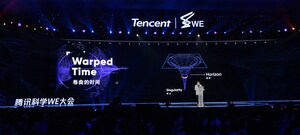SY Lau of Tencent Lays Out the Latest Trends of Digital China To Maurice Levy, CEO of Publicis in Cannes
Marketers in China must catch up with the explosive growth of the mobile Internet, and only those who adapt to rapid change will thrive
BEIJING, June 24, 2014 /PRNewswire/ -- The three key factors driving the China Internet today are the digital economy, digital behavior and the digital marketing eco-environment, said SY Lau, president of Tencent online media group and senior executive vice president of Tencent, speaking at a high-level seminar organized by world-renowned advertising and communication group Publicis. The seminar took place on June 20, during the 61st Cannes International Festival of Creativity in Cannes, France, where SY Lau also enjoyed a one-on-one conversation with Maurice Levy, chairman and CEO of Publicis.
SY Lau addressed an audience of representatives from outstanding companies around the world spanning across different industries. At the heart of his in-depth discussion were the three key elements he said are shaping the look and feel of the Internet in China, namely the rise of the Internet as an economic force tightly integrated with offline businesses; the effect on user behavior as Netizens increasingly turn to the Internet for consumption; and the joining together of traditional industries and new technology for marketing across China's vast digital ecosystem.
The Digital Economy
Rapid development, greater dynamism and increasing integration with offline industries have made China's digital economy more sophisticated, SY Lau said, and its development has now exceeded the level in Western countries thanks to the unprecedented growth of China's mobile Internet. Nearly 90 percent of Chinese Internet users go on line via mobile devices while in the U.S. it is only about 60 percent. The digital economy is contributing more and more to China's overall economy and The Boston Consulting Group predicts that by 2016 it will comprise 6.9 percent of the nation's GDP.
One of the most remarkable features of China's Internet development has been its integration with offline industries. As an example, SY Lau pointed to the real-time taxi-booking app DiDi Call-A-Cab, which has attracted over 220 million users in 16 months, and processes 160 thousand orders per day. This is a perfect example of the integration of the digital economy and China's transportation industry. Thanks to the entrepreneurial spirit of Internet innovators, there are many examples of entrepreneurs turning to the Internet to grow their businesses, especially new and small companies seeking to expand.
Digital Consumer Behavior
In his conversation with SY Lau, Levy expressed great interest in how Chinese consumer behavior was evolving in the new digital era. SY Lau said that with easy access to e-commerce, product information and secured e-payment, digitalization has allowed the online consumption power of the Chinese people to soar, particularly in the smaller cities. The Internet has enabled Chinese consumers to enjoy the benefits of global pricing thanks to reduced channel cost, while transparency of information eliminates unfair pricing. Within the next decade 75 percent of China's middle class will come from third and fourth-tier cities.
In addition, there has been an emergence of "smart consumers" who turn to social media and other online resources for product information, making them better-informed buyers. And this works both ways: consumers can give timely feedback to producers, who in turn can optimize the production process and volume to reduce waste. Consumers' participation in production decision-making is now a reality.
With 500 million smart phone users, China's mobile Internet is not only altering consumer behavior, it is helping to reshape the country socially as citizens increasingly turn to their mobile devices for consumption and information. Internet users are showing an urgent need for mobile digitalization. China is shifting from the 3G network to 4G, which will in turn stimulate mobile Internet development.
China's Digital Marketing Eco-environment
Levy also asked SY Lau what the digital eco-system in China now looks like, and how marketing will evolve with it.
"I believe that digital technology will develop around a core concept, 'Internet+,'" SY Lau replied. "China's Internet will be increasingly integrated with other technologies and industries, and marketing is expected to evolve with the emergence of new business models. Those who adapt the fastest and with the most agility will succeed. Marketers will have to do all they can to catch up and keep up with the changing ecosystem."
As to whether social media and social apps like WeChat, Tencent's popular messaging communication service, are a bane or boon for brands, SY Lau responded that WeChat is far more than a social media, but also an interface with the new economic ecosystem established by the mobile Internet. Its aim is to partner with offline businesses for a mobile-first world, and to support and supplement the entire ecosystem. For brands, the value of WeChat is the opportunity it presents to combine content with community and commerce, serving to build a win-for-all relationship between media, brands, and users.
With everything connected by the mobile Internet, brands in China must shift their roles from persuaders to enablers, SY Lau remarked. Brands need to pay closer attention to the purchasing path of users, focusing on closing the deal rather than touch points alone. Since the mobile Internet is decentralizing information and distribution, brands will need more agile applications of marketing resources so users can enjoy faster and more customized services.
SY Lau concluded that it was still important to hold on to the very core of marketing - outstanding creativity and moving content, and not to get lost along the way of digitalization. In the future, the ultimate winning agencies will be those that realize an ideal blend of creativity and technology.
Photo - http://photos.prnewswire.com/prnh/20140624/120826
SOURCE Tencent
WANT YOUR COMPANY'S NEWS FEATURED ON PRNEWSWIRE.COM?
Newsrooms &
Influencers
Digital Media
Outlets
Journalists
Opted In




Share this article